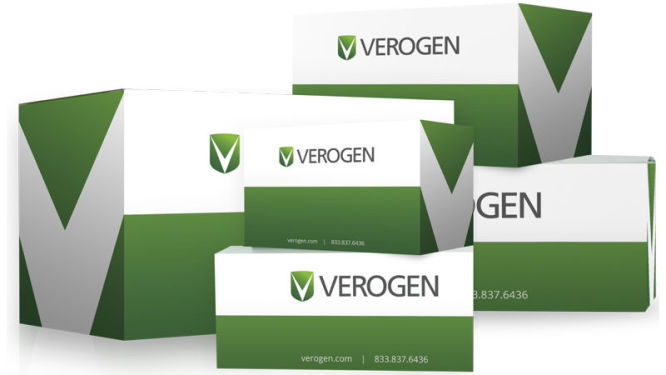✓ 24/7 automatic processing of online orders
✓ Knowledgeable and professional Product & Technical Support
✓ Fast and reliable (re)-ordering
Verogen ForenSeq mtDNA Control Region Kit
Cat. No. / ID: V16000085
✓ 24/7 automatic processing of online orders
✓ Knowledgeable and professional Product & Technical Support
✓ Fast and reliable (re)-ordering
Features
- Optimum sensitivity from minimal DNA input
- Enhanced variant detection using small amplicons from the latest databases
- Excellent resolution for severely degraded samples
- Multiplexing capability further boosts operational efficiency
Product Details
The ForenSeq mtDNA Control Region Kit offers convenient, efficient library prep for interrogating the control region of the mitochondrial genome (mtGenome) with minimal DNA input and optimum sensitivity. Leveraging proven ForenSeq chemistry, the kit produces a concise data set from the entire control region for direct upload to CODIS. Multiplexing capability boosts operational efficiency without increases to costs or time.
Performance
The ForenSeq mtDNA Control Region Kit links a powerful assay with industry-leading sequencing and integrates seamlessly with intuitive software for optimum laboratory efficiency. The ForenSeq mtDNA Control Region workflow is completely flexible and scalable for all throughput requirements, allowing laboratories to quickly generate complete mtDNA control region results for up to 48 samples simultaneously in less than two working days. For low throughput requirements, the kit’s 48 reactions maintain a 12-month shelf-life and for higher demand laboratories, a similar library preparation routine makes automation easy.
- Short mean amplicon size for maximum variant detection
- Optimized for inhibitor tolerance
- Flexible and scalable throughput
- Integrated workflow for optimum laboratory efficiency
The high density of mutations concentrated in the mtDNA control region and the degraded nature of most forensic samples in which mtDNA analysis is used make optimal primer design challenging. The ForenSeq mtDNA Control Region kit is optimized to generate complete and actionable coverage, even for very low input amounts (see figure “The ForenSeq mtDNA Control Region system delivers extensive coverage across a wide range of DNA input amounts”).
To improve performance on highly degraded material, the ForenSeq mtDNA Control Region kit uses more than 120 primers, designed from recently curated mtDNA variant and frequency data, generating 18 primary amplicons in the mtDNA control region. All primary amplicons are <150 bp in length, many < 100 bp – the lowest average amplicon size of any current commercial mtDNA assay system. All amplicons have a minimum overlap of 3 bp to avoid gaps in sequence following post run, bioinformatic trimming. A buffer system optimized for inhibitors that creates a robust amplification environment (see figure “An improved ForenSeq buffer system maximizes performance“).
| Feature | Details |
| Target size | 1200 bp mtDNA control region |
| DNA input recommendation | 100 pg gDNA and mtDNA per sample |
| Sample types | DNA extracted from a range of degraded samples, including bone, teeth and hair shaft |
| Recommended multiplexing capacity | 3–48 libraries per run |
| Number of primers | >120 |
| Number of amplicons | 18 |
| Average amplicon size | 118 bp |
| Amplicon overlap | ≥ 3 bp |
| Total library prep time | 7 hours and 45 minutes |
| Hands-on time | 1 hour and 30 minutes |
Principle
The PCR-based assay deploys small amplicons sourced from the latest mitochondrial (mtDNA) databases for enhanced variant detection. A tiled approach overlaps the amplicons to prevent the sequence gaps that can lead to data loss, particularly in degraded samples. Complementing this tiled primer design, an enhanced buffer system delivers exceptional resistance to calcium, humic acid, and other relevant PCR inhibitors.
Procedure
This user-friendly, automation-compatible solution provides a common workflow for a variety of study designs spanning multiple applications. The protocol includes two normalization methods to tailor library prep for a broad range of input material, from high-quality genomic DNA (gDNA) through low-level and complex samples, while a low input requirement expands possibilities for the most challenging samples. For efficient use of the reagent kit and accurate read assignment, index adapters provided in the library prep kit allow pooling and sequencing of up to 48 samples in one run.
Applications
Mitochondrial DNA is a powerful alternative source of information when nuclear DNA is compromised or absent. Used for rootless hairs, teeth, bones, and other challenging sources, mtDNA has become routine for missing persons and disaster victim identification efforts. Previously, quality and scaling issues associated with traditional Sanger sequencing methods have confined mtDNA to a limited role in a few specialty centers. Verogen mtDNA workflows offer a unique combination of performance, efficiency, and ease of use so that any lab, of any size, can transition mtDNA analysis from Sanger sequencing to NGS, or improve your results obtained from other NGS technologies.
Software
The ForenSeq mtDNA Control Region Kit pairs seamlessly with the ForenSeq mtDNA Analysis Module in UAS for ease-of-use and rapid review of mtDNA data. The software analyzes sequencing output for the control region and provides results less than one hour after run completion. Laboratories can review summarized or detailed results and compare up to nine samples on a clear and interactive user interface. Reports are compatible with multiple DNA databases.
Services
We offer superior support across the entire workflow, from library prep to sequencing to analysis. Our experienced team provides comprehensive service coverage for your equipment and software, validation plans, and implementation guidance so you can quickly operationalize your workflows with ease.

